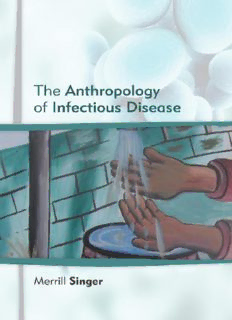
The Anthropology of Infectious Disease PDF
Preview The Anthropology of Infectious Disease
Anthropology of Infectious Disease Honoring his landmark contributions to the anthropological study of infectious disease and to the biocultural synthesis that has guided such work, this book is dedicated to the memory and inspiration of George J. Armelagos, 1936–2014. Merrill Singer The anthropology of infectious disease Walnut Creek CAlifornia Left Coast Press, Inc. 1630 North Main Street, #400 Walnut Creek, CA 94596 www.LCoastPress.com Copyright © 2015 by Left Coast Press, Inc. All rights reserved. No part of this publication may be reproduced, stored in a retrieval system, or transmitted in any form or by any means, electronic, mechanical, photocopying, recording, or otherwise, without the prior permission of the publisher. ISBN 978-1-62958-043-2 (hardback) ISBN 978-1-62958-044-9 (paperback) ISBN 978-1-62958-045-6 (institutional ebook) ISBN 978-1-62958-046-3 (consumer ebook) Library of Congress Cataloging-in-Publication Data Singer, Merrill. Anthropology of infectious disease / Merrill Singer. pages cm Includes bibliographical references and index. ISBN 978-1-62958-043-2 (hardback)— ISBN 978-1-62958-044-9 (paperback)— ISBN 978-1-62958-045-6 (institutional ebook)— ISBN 978-1-62958-046-3 (consumer ebook) 1. Communicable diseases. 2. Medical anthropology. I. Title. RA643.S56 2015 616.9—dc23 2014030349 Printed in the United States of America ∞ ™ The paper used in this publication meets the minimum requirements of American National Standard for Information Sciences—Permanence of Paper for Printed Library Materials, ANSI/NISO Z39.48–1992. Cover design by Piper Wallis Cover photo by Laura R. Wagner Contents List of Illustrations 7 Acknowledgments 9 IntroduCtIon Anthropology and the Large Impact of Small Worlds 11 Chapter one Defining the Anthropology of Infectious Disease: Toward a Biocultural/ Biosocial Understanding 20 Chapter two Denizens of the Microbial World 60 Chapter three More Than Human 101 Chapter Four Environmental Disruption, Pluralea Interactions, and Infectious Diseases 125 Chapter FIve Emergent, Reemergent, and Drug-Resistant Infectious Agents 156 Chapter sIx Infectious Disease Syndemics 196 Chapter seven Inequality, Political Ecology, and the Future of Infectious Diseases 225 Glossary 267 References 284 Index 315 About the Author 320 illustrations figures Figure I.1 19th century illustration of Herpes gladiatorium skin infection 12 Figure 1.1 Early 20th century photo of urban poverty entitled “A Consumptive Mother and Her Two Children at Work” 43 Figure 1.2 Aegypti mosquito lava in research laboratory 50 Figure 1.3 Physician in the Philippines being instructed about the Aedes aegypti mosquito 54 Figure 2.1 Stromatolites in Australia 62 Figure 2.2 Centers for Disease Control measles immunization poster 71 Figure 2.3 Staphylococcus 79 Figure 2.4 Sucking Anopheles mosquito 89 Figure 2.5 1960s public health message 96 Figure 3.1 Trichinella spiralis, a parasitic worm 106 Figure 3.2 HIV testing in Lesotho in Southern Africa 113 Figure 3.3 Human immunodeficiency virus 114 Figure 4.1 Schistosomiasis prevention poster 129 Figure 4.2 Access to clean water is a significant factor in infectious risk: Lesotho in Southern Africa 130 Figure 4.3 Tripartite model of biosocial penetration 131 Figure 4.4 Risk of water-borne infectious diseases 132 Figure 4.5 Water-borne disease routes, dog drinking from dishwashing bucket at open air market in Quito, Ecuador 142 Figure 4.6 Urban breeding ground for infectious diseases, Cite Soleil, Haiti 144 Figure 4.7 Wall mural on cholera epidemic in Haiti 145 Figure 4.8 Cholera prevention billboard in Haiti 146 Figure 4.9 Pathogenic agent of bubonic plague 154 Figure 5.1 Smallpox vaccination 158 Figure 5.2 Polio eradication campaign, Kolkata, India 159 Figure 5.3 Oral poliovirus vaccine administration 161 Figure 5.4 1940s malaria control in Teheran, Iran 165 Figure 5.5 Infectious disease researcher, Iquitos, Peru 168 Figure 5.6 X-ray of Mycobacterium tuberculosis infection X-ray 170 Figure 5.7 Unrefrigerated meat for sale in open air market in Quito, Ecuador 175 Figure 5.8 In the midst of the cholera epidemic crabs for sale in the open air market in Quito, Ecuador 183 Figure 6.1 Influenza and tuberculosis prevention poster, Rensselaer Country Tuberculosis Association 202 Figure 6.2 The SAVA syndemic 214 Figure 6.3 Injection drug use emerged as an important route of HIV infection 216 Figure 7.1 Prevention poster used in theaters in Chicago during the 1918 influenza pandemic 251 Figure 7.2 Biosafety Level 4 infectious disease laboratory worker wearing protective gear 254 Figure 7.3 Cutaneous anthrax lesions on a man infected with the bacterium Bacillus anthracis 256 tables Table 1.1 Components of the anthropology of infectious disease 37 Table 2.1 Pathogenic sources of various diseases 68 Table 3.1 Tickborne diseases of the U.S. 116 Table 4.1 Infectious diseases that are spreading because of global warming 135 Table 5.1 Pathogens studied as possible agents for use in biological warfare 193 9 acknowledgement Deep appreciation is extended to Jennifer Collier Jennings, my editor at Left Coast Press. I would be a very rich man if I had a dollar for all of the suggested changes she provided for this book.
Description: